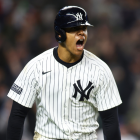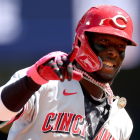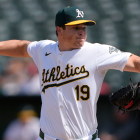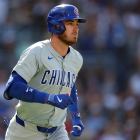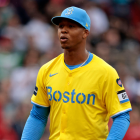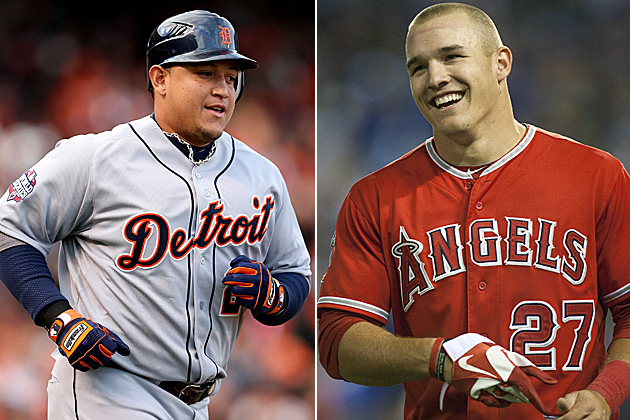 |
| Batting average or on-base percentage? RBI or runs scored? (Getty Images) |
With the AL MVP finally being named Thursday night, we can now conclude the arguments over which stats carry the most weight on the field.
Or can we?
What better time than now to delve into what exactly are the best offensive stats upon which to judge a baseball player? The Eye on Baseball staff -- Matt Snyder, C. Trent Rosecrans and Dayn Perry -- will do the heavy lifting and then let our readers argue among themselves. We'll make our picks, too, so you can call us idiots, as is standard in the Internet community.
This is Part I of a three-part series, as we'll also do this with pitching (next Monday) and defense (Tuesday).
Here are our nine candidates for best primary offensive stat -- and please note that every offensive stat here is very important, we're just trying to pick which is the top dog. Also note, categories such as doubles, triples and stolen bases are clearly important but couldn't be rationally argued as the most important stat. Thus, they were left out. - Matt Snyder
The Candidates
Batting average (AVG): Right off the bat, we've got to say that batting average is not the best stat to judge offense. There's too many things wrong, starting with the fact that there are a lot of variables involved such as not including walks, or the subjective nature of awarding hits and errors. Still, what batting average does have over all the other statistics is history and context. We all know what a .300 hitter is, we know how bad a .200 hitter is and how great a .400 hitter is. We still celebrate the batting crown, and although not as much as we once did, it still means something and probably should. -- C. Trent Rosecrans
On-base percentage (OBP): Unlike batting average, on-base percentage doesn't ignore working the count to earn a walk, stepping into an inside pitch or being such a terrifying hitter that one gets pitched around and/or intentionally walked often. There are four players with more than 2,000 career walks: Barry Bonds, Rickey Henderson, Babe Ruth and Ted Williams. And we're supposed to ignore that and concentrate on batting average? In its purest form, OBP is basically measuring the amount of times a hitter does not make an out. With only 27 precious outs in a regulation game, this stat is paramount. That this isn't mainstreamed as more important than batting average makes very little sense to me. [For more on AVG vs. OBP, click here. I wrote a lot more about it] -- Snyder
| Eye on Baseball |
| Offseason content |
|
Slugging percentage (SLG): Compared to most of the other "old" statistics, slugging is beautiful in its simplicity -- it's simply total bases divided by at-bats, and gives us a nice snapshot of a player's power. Think about it, with batting average you have to factor in fielder's choices, errors and walks and the such, while slugging is easy (although, it is a derivative of batting average, as you need at-bats instead of plate appearances). It also passes my test for a useful stat -- immediate understanding of what it means when you glance at the number. - Rosecrans
On-base percentage plus slugging percentage (OPS): Yes, this is a made-up, smashing together of two useful stats to make a mega-useful stat. Or, somewhat useful stat. I'll say this, since I also had the batting average and slugging percentage entries, I'm a big, big fan of the slash line, it gives you a basic idea of what kind of hitter a player is with three simple stats. Of those three, really, the batting average is the least important, I want to know how much a guy doesn't make an out and how much power he has. OPS tells me that, and despite different ways to get the job done (high on-base, low slugging speedy guy or big slugger who doesn't get on as much) a certain OPS gives me an idea, at least, that no matter what he looks like, he's productive. - Rosecrans
Adjusted OPS-plus (OPS+): You might be familiar with OPS, which is simply on-base percentage added to slugging percentage (forget, for the moment, that they have different denominators). OPS+ is simply OPS adjusted for park and league conditions. It's scaled to 100, which means that 100 indicates a league-average OPS adjusted for park and league. An OPS+ of 110, for instance, is an OPS that's 10 percent better than the league average. On the other end, an OPS+ of 85 is one that's 15 percent worse than the league average. It's useful in that you can make a thumbnail comparison between, say, a hitter in Coors Field in 2000 to one in Dodger Stadium in 1968. It helps correct for the two things that most often corrupt unadjusted stats -- home parks and eras -- and it leans on the the two most important things a hitter can do -- get on base and hit for power. - Dayn Perry
Offensive wins above replacement (oWAR): I like it because it removes the problematic portion of WAR, which is its defensive estimates. oWAR is all about contributions made at the plate and on the bases, and it measures those quite well. It's denominated in theoretical runs tied to "replacement level," which approximates the productivity of a "freely available" sort of player (e.g., the bench player, the minor-league veteran, the waiver claim). Batting, base-running and an adjustment for positional difficulty are all baked in. - Perry
Home runs (HR): The argument for this one is pretty simple. The best possible thing a hitter can do in any given at-bat is hit a home run. No matter what. You can't name a single offensive circumstance where something else would help the team more than a home run. My disdain for hearing "we don't need a home run" is a topic for a different day. Still, even the leaders in home run totals each year generally hit a home run around 5 to 10 percent of the time. So if you only focus on homers and ignore everything else, the odds of coming up with the best overall offensive player probably aren't great. - Snyder
Runs batted in (RBI): It's one of the most familiar and comfortable offensive stats around, and it's still got plenty of advocates. It's one of my least favorites, not only because of its native weaknesses but also because of its outsized importance when it comes to awards, bar-stool debates and the like. The primary problem with RBI is that it's highly, highly team-dependent. After all, it's hard to drive in many runs unless runners are getting on base in front of you, and that's not something you can control. Additionally, it's highly dependent upon your spot in the lineup. Take the exact same two hitters, put one in the leadoff spot and one at clean-up and you're going to get vastly different RBI totals. Like any traditional counting stat it's useful at the margins (e.g., it's hard to drive in 130 runs and somehow suck, but it's entirely possible to plate 100 runs and not be a useful player). Mostly, if you feel compelled to pay attention to RBI, don't do so without also paying attention to RBI percentage, or the percentage of runners than a batter plated. You can't consider RBI without also considering opportunities for RBI. - Perry
Runs scored (R): Aside from when a player hits a home run, he'll need some help from teammates -- most of the time -- to score a run. Still, players can do a lot to increase the number of times they score. Getting on base frequently, stealing bases, taking extra bases on singles or doubles, taking a base on a passed ball right in front of the catcher or even being such a scary baserunner to draw a balk are ways to spin around the bases better than others. Guys who score the most runs are great players, not those simply lucky to have good teammates driving them in. Here are the top 10 all-time in runs scored: Rickey Henderson, Ty Cobb, Barry Bonds, Hank Aaron, Babe Ruth, Pete Rose, Willie Mays, Cap Anson, Stan Musial and Alex Rodriguez. Marginalize that group at your peril. - Snyder
Obviously there are plenty more categories out there, especially with the sabermetric movement, but those are our nine primary candidates for this exercise.
Our staff picks
Matt Snyder: On-base percentage
It's easy for me here if I'm judging a player or team in any given season, because OBP is essentially measuring the amount of times a player doesn't make an out. If no one ever makes an out, I'm pretty sure the team would find a way to do just fine on the scoreboard, right? As for judging players in a historical context, I'll go with OPS+ because it lumps in on-base ability with power and adjusts for all eras, from the steroid era to dead-ball era and everything in between.
C. Trent Rosecrans: OPS+
I'm an agnostic when it comes to a silver bullet statistic. Sure, it might exist somewhere, but I haven't seen evidence to support that. Instead, I think the sheer number and variety of statistics we have show just how much beauty and nuance there is in the game, and why it's the greatest game that's ever been. That said, I like OPS+ because it incorporates many different things -- getting on base (i.e. not making outs) and slugging, while also putting those performances into the context of a time (the season) and place (ballaparks). I also like the simplicity of 100 being average -- so if you see something like Barry Bonds' run of four years with a 230 or better OPS+ is simply superhuman (or some may say, unnatural).
Dayn Perry: OPS+
On an individual level, I'm partial to OPS+ because it's a clear upgrade over traditional measures and, unlike oWAR (which I think is more accurate in a vacuum), it's not quite as off-putting to the uninitiated. I'll happily lean on oWAR when appropriate, though, as it contains a base-running component. On a team level, I tend to stick to runs scored and OPS with on-the-fly adjustments made for ballpark effects.
Now it's your turn, readers. What is the best primary offensive stat upon which to judge a hitter?
For more baseball news, rumors and analysis, follow @ EyeOnBaseball on Twitter, subscribe to the RSS feed and "like" us on Facebook.












